BED BATH & BEYOND
Bed Bath and Beyond Rooms
Empowering college students to easily visualize, curate, and share their ideal rooms.
OVERVIEW
Bed Bath & Beyond is an American retailer of home goods and furnishings.
With over 1,000 stores, the company aims to make customers feel at home through quality products and excellent service. Facing a decline in revenue, Bed Bath & Beyond is now focused on innovative strategies to refresh its brand.
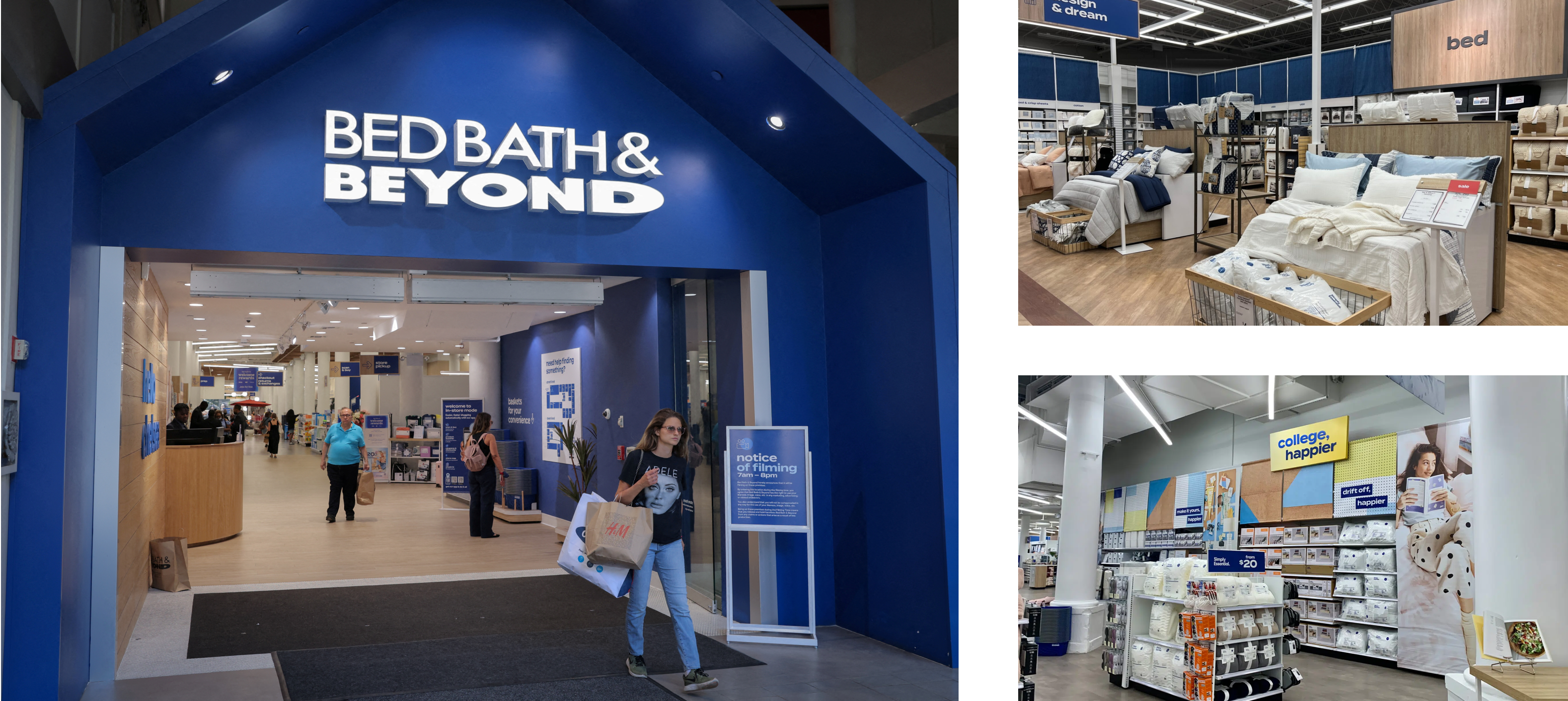
THE CHALLANGE
To provide a unique shopping experience that sets Bed Bath & Beyond apart from competitors during the college season.
College season is crucial for big-box retailers to capitalize on back-to-school shopping and gain substantial annual revenue. Bed Bath & Beyond, facing a revenue decline of nearly 32% from $12.4 billion in 2018 to $8.4 billion in 2021, found it challenging to distinguish itself in a competitive market.
MY ROLE
I led the user experience and interaction design.
I collaborated closely with another product designer, Sarah, who focused on visual design and content strategy. The early phases of research and testing were a collaborative effort, with responsibilities split evenly between us. We had a total of 7 weeks to produce a prototype

Discovery
We conducted market analysis and user research, using quantitative surveys and qualitative interviews to understand the market and our users.

MARKET ANALYSIS
We identified the success and opportunities of other products.
competitive and comparative research provided us with insights that guided our strategy to create a seamless and engaging shopping experience. These insights include...
1. Enhanced Product Discovery
Competitors help consumers easily find and save items with curated recommendations.
2. Streamlined Checkout Process
Platforms streamline checkout to minimize time and effort, boosting user satisfaction.
3. Item Grouping
Platforms organize products into cohesive sections, simplifying the shopping process.
4. Budget Integration
Competitors often lack clear budgeting tools for transparency and financial planning.
USER RESEARCH
Conducting user interviews and surveys provided deep insights into user behaviors and preferences.
We conducted qualitative interviews and quantitative surveys, gathering insights from over 70 participants. This helped us empathize with our users and understand their challenges. Here are the key insights we uncovered...
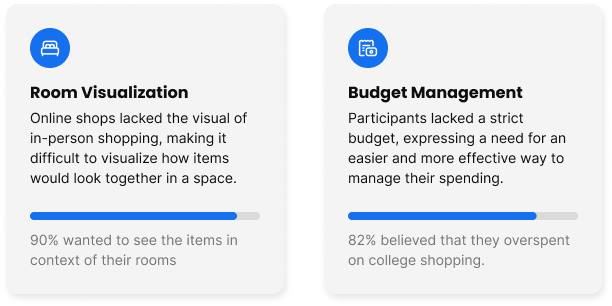

USER PERSONAS
Creating personas helped to humanize our target users and guide design decisions.
Personas provide a reference point throughout the design process, ensuring we stay focused on user needs. By regularly referring to these personas, we can validate that our design decisions align with user expectations and preferences.
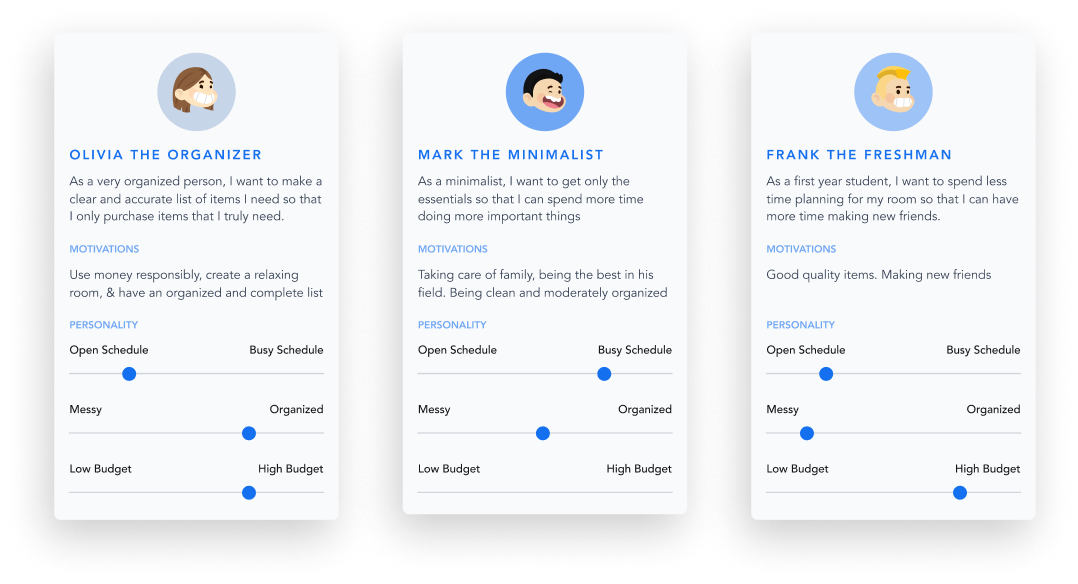

Define
With a comprehensive understanding of user behaviors, needs, pain points, and competitive insights, we define the problem and identified opportunities to enhance the user experience.
PROBLEM STATEMENT
Bed Bath & Beyond's current shopping experience for college students lacks the digital tools and personalized approach needed to manage budgets, coordinate with roommates, and discover their style, leading to overspending and dissatisfaction.
HOW MIGHT WE
Formulating "How Might We" statements helps reframe challenges as opportunities for innovation.
These statements guide brainstorming sessions and solution development.

OPPORTUNITY AREAS
We identified three opportunities to helps us find innovative ways to address user needs.
1. List Creation Tools: Create an engaging platform for list creation to streamline the shopping process and minimize the tediousness.
2. Styling Tools: Provide tools to help college students identify their style and create a cohesive, aesthetically pleasing room.
3. Financial Tools: Develop budgeting tools to help students purchase necessary items while staying within their budget.

Develop
With a clear problem definition and key opportunities identified, we moved on to brainstorming and developing specific solutions to address these needs.
OPPORTUNITY 1
List Creation Tools

OPPORTUNITY 2
Styling Tools

OPPORTUNITY 3
Budgeting Tools

EVALUATION
We presented our ideas to eight potential users to gather feedback on the paper prototypes.
Users ranked several aspects of the ideas and provided feedback through open discussions, assessing the criteria of usefulness, usability, accessibility, and delightfulness. We recieved valuable feedback that highlighted the strengths and areas for improvement in our proposed solutions.
1. Interactive List Creation
Users enjoyed the interactive and collaborative aspects of the list creation tools, which made shopping more engaging and organized.
2. Real-Time Budget Tracking
Real-time budget tracking and cost-splitting features were found to be useful for managing finances and collaborating with roommates.
3. Personalized Style Recommendations
Users appreciated the personalized style recommendations and 3D room visualization, which increased their confidence in their choices.
4. Usability Improvements
Some users found certain features overwhelming and suggested adding tutorials or guides to improve usability.
REFINEMENT
We refined our ideas into two distinct solutions to address user needs and differentiate from existing market offerings.
College season is crucial for big-box retailers to capitalize on back-to-school shopping and gain substantial annual revenue. Bed Bath & Beyond, facing a revenue decline of nearly 32% from $12.4 billion in 2018 to $8.4 billion in 2021, found it challenging to distinguish itself in a competitive market.
OPPORTUNITY 1
List Creation Tools

A tool that provides personalized product suggestions and curates lists based on user input.
OPPORTUNITY 1
List Creation Tools

A gamified list creation experience where users visit themed islands for different categories.
OUR SOLUTION
An interactive shopping experience that allows consumers to curate their ideal living space by integrating personalization, budgeting, and collaboration.
Users can create, share, and design rooms for bed, bath, and beyond products. Key features include intuitive onboarding, customized product suggestions, budgeting tools, and collaborative lists, ensuring an easy and engaging shopping process tailored to individual and group needs.


Key Features
We conducted market analysis and user research, using quantitative surveys and qualitative interviews to understand the market and our users.
Onboarding
Gauges user needs through questions to provide personalized suggestions based on budget, style, and room preferences.

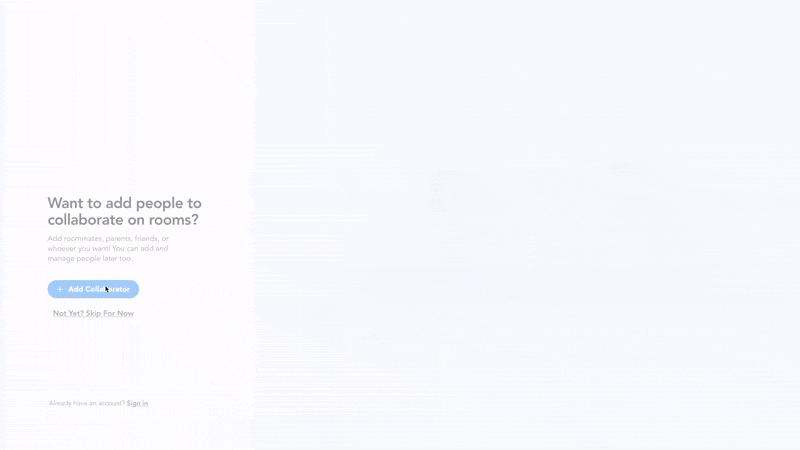
Collaboration
Allows users to add roommates, friends, and parents to collaboratively create and manage shopping lists.
Tutorial
A quick walkthrough to help new users understand and navigate the platform.
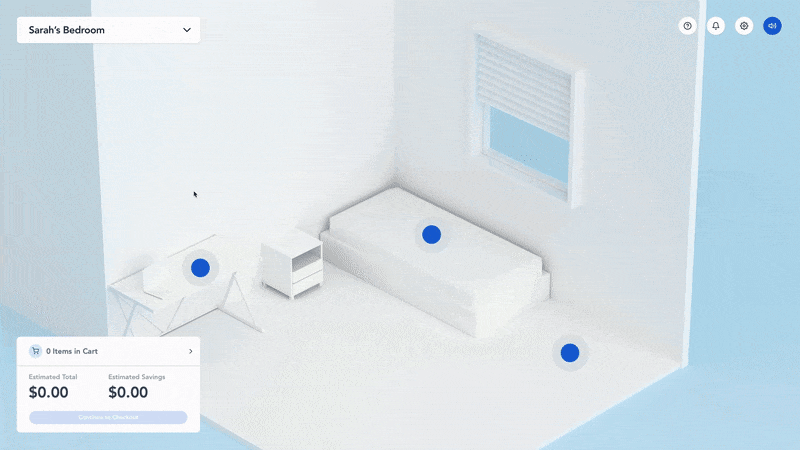
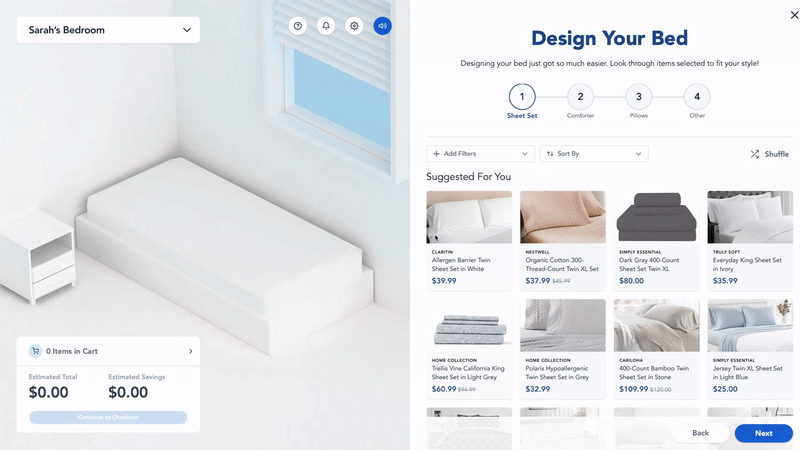
Customize
Offers curated product suggestions based on previous selections to help users personalize their rooms.
Navigate
Enables users to see all their items and efficiently navigate through different rooms.

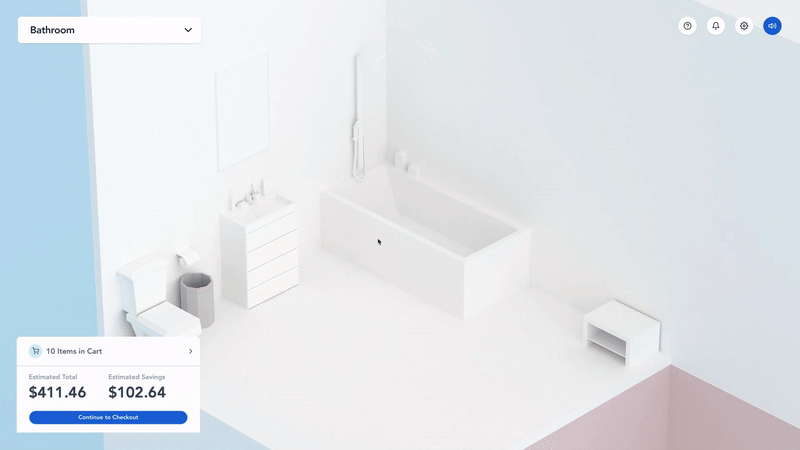
Split costs
Allows users to split the costs of shared items with roommates for transparent and fair expense distribution.
Business Impact
Personalization
Data-driven recommendations effectively target and personalize user experiences.
Loyalty
Visualization and interactivity deepen user engagement, boosting brand loyalty.
Promotion
Enhances brand promotion efforts, leading to increased visibility and sales growth.

Evaluation
After refining our ideas and features based on research and user testing, we implemented the final solution and gathered feedback from both the Bed Bath & Beyond team and potential users.
FEEDBACK
The final phase involved end to end user testing and gathering feedback to validate and enhance our solution.
We implemented the final solution and collected valuable insights from both the Bed Bath & Beyond team and potential users. This feedback will guide us in making future improvements.
"I loved how easy it was to customize my room with the 3D visualization tool. It made the whole shopping experience fun and interactive”
~Alex, Student
While we recognize that implementing this might require significant effort, we believe the impact it will have on our brand makes it well worth the investment."
~ Designer @ Bed Bath & Beyond
"I really liked the onboarding process. It was quick, and the personalized suggestions make it super helpful.”
~Rachel, Student
"This solution is very creative. It really sets us apart from the competition and offers something truly unique to our customers."
~ Designer @ Bed Bath & Beyond
NEXT STEPS
Our focus will be on scaling the project to reach a broader audience and enhancing key features.
1. Enhance Collaborative Features: Focus on adding more collaborative functionalities, such as uneven cost splitting, shared saved lists, and merging room styles.
2. Continue User Testing and Iteration: Use the interactive prototype to gather ongoing feedback, refine the features, and make data-driven improvements.
3. Scale the Project: Expand the solution for a wider audience, including new grads and newlyweds, to maximize its impact.
LEARNINGS
I learned about balancing user experience with business needs and the importance of focusing on key features.
1. Balancing User Experience with Business Needs: We learned the importance of designing an optimal user experience while also considering and compromising with business objectives. After all this has to make money!
2. Focus on the Bigger Picture: Since this was a proof of concept rather than a full end-to-end solution, we didn’t need to have everything figured out. Instead, we focused on the happy path and key features, which allowed us to move quickly and efficiently.
~FIN~
Thanks for checking out this case study!
